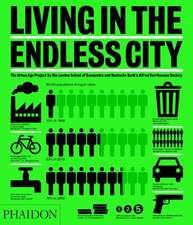Designing the Urban Renaissance: Sustainable and competitive place making in England
Autor Francesco Vescovien Limba Engleză Hardback – 11 ian 2013
Readers interested in urban policies, architecture and the built environment will find a concise yet comprehensive explanation, enriched by more than a hundred pictures, on why and how many towns and cities like Birmingham, Nottingham, Leicester or Sheffield have been changing during the last decade.
| Toate formatele și edițiile | Preț | Express |
|---|---|---|
| Paperback (1) | 635.31 lei 6-8 săpt. | |
| SPRINGER NETHERLANDS – 23 aug 2016 | 635.31 lei 6-8 săpt. | |
| Hardback (1) | 644.95 lei 6-8 săpt. | |
| SPRINGER NETHERLANDS – 11 ian 2013 | 644.95 lei 6-8 săpt. |
Preț: 644.95 lei
Preț vechi: 758.77 lei
-15% Nou
Puncte Express: 967
Preț estimativ în valută:
123.43€ • 128.38$ • 101.90£
123.43€ • 128.38$ • 101.90£
Carte tipărită la comandă
Livrare economică 14-28 aprilie
Preluare comenzi: 021 569.72.76
Specificații
ISBN-13: 9789400756304
ISBN-10: 9400756305
Pagini: 150
Ilustrații: XVIII, 173 p.
Dimensiuni: 155 x 235 x 17 mm
Greutate: 0.54 kg
Ediția:2013
Editura: SPRINGER NETHERLANDS
Colecția Springer
Locul publicării:Dordrecht, Netherlands
ISBN-10: 9400756305
Pagini: 150
Ilustrații: XVIII, 173 p.
Dimensiuni: 155 x 235 x 17 mm
Greutate: 0.54 kg
Ediția:2013
Editura: SPRINGER NETHERLANDS
Colecția Springer
Locul publicării:Dordrecht, Netherlands
Public țintă
GraduateCuprins
Introduction.-The Recent Reform of the English Planning System.- New strategic drivers for the regeneration of cities.- Stakeholders, programmes, strategies.- Elements of design strategy.- The role of housing: city living, communities, places.- Conclusions: short notes on the English lesson.
Notă biografică
Dr. Arch. Francesco Vescovi graduated in Architecture (specialization Urban Design) in Milan in 1972. He worked as consultant for three years in Milan at the City Council’s Department for Urban Regeneration (Assessorato alle Periferie). In 2005 he graduated his PhD in Architecture, Urban Design and Landscape Conservation, Politecnico di Milano with a research on ‘city marketing and urban design strategies'. He is now lecturer in Urban Design at the Faculty of Civil Architecture of Politecnico di Milano, Italy.
Textul de pe ultima copertă
The economic and social challenges brought by globalization and the inevitable prospect of a commitment to sustainable development have induced the UE to put towns and cities at the heart of the current political agenda. Urban and metropolitan areas are considered as primary resources for the regeneration of the territory and for the distribution of wealth among the population. The initial and admirable example of Barcelona was soon joined by similar initiatives across the continent, according to a widespread process of urban renaissance driven by new instances of competitiveness and sustainability.
In England this trend led the New Labour Government, properly addressed by the research report of the Urban Task Force in 1999, to renew the old planning system and to establish new rules and financial resources to stop the physical and economic decline of many urban areas, supporting initiatives and projects to bring people and jobs back in the heart of towns and cities.
Urban design – the main focus of the book – is considered by the government one of the most effective tools for controlling the ongoing processes of transformation, raising the overall quality and degree of urbanity of places and ensuring a proper balance between the necessary aesthetic, environmental, social and economic requirements.
The research describes the support given to local authorities for this purpose through new laws and powers, the publishing of planning and design manuals and the delivery of especially dedicated funds, bodies and programs. It also explores the character and purpose of new developments such as scientific parks, creative/cultural quarters, retail and commercial districts, public realm works, describing critically recurring design rules and features.
Readers interested in urban policies, architecture and the built environment will find a concise yet comprehensive explanation, enriched by a lot of pictures, on why and how many towns andcities such as Birmingham, Nottingham, Leicester or Sheffield have been changing during the last decade.
In England this trend led the New Labour Government, properly addressed by the research report of the Urban Task Force in 1999, to renew the old planning system and to establish new rules and financial resources to stop the physical and economic decline of many urban areas, supporting initiatives and projects to bring people and jobs back in the heart of towns and cities.
Urban design – the main focus of the book – is considered by the government one of the most effective tools for controlling the ongoing processes of transformation, raising the overall quality and degree of urbanity of places and ensuring a proper balance between the necessary aesthetic, environmental, social and economic requirements.
The research describes the support given to local authorities for this purpose through new laws and powers, the publishing of planning and design manuals and the delivery of especially dedicated funds, bodies and programs. It also explores the character and purpose of new developments such as scientific parks, creative/cultural quarters, retail and commercial districts, public realm works, describing critically recurring design rules and features.
Readers interested in urban policies, architecture and the built environment will find a concise yet comprehensive explanation, enriched by a lot of pictures, on why and how many towns andcities such as Birmingham, Nottingham, Leicester or Sheffield have been changing during the last decade.
Caracteristici
Treats together urban policies, architecture and urban design in order to deliver a comprehensive view of the phenomenon Gives a detailed example of urban renaissance that can be used for other european cities Useful for students in architecture and urban design, but also for professionals and policy makers Includes supplementary material: sn.pub/extras















